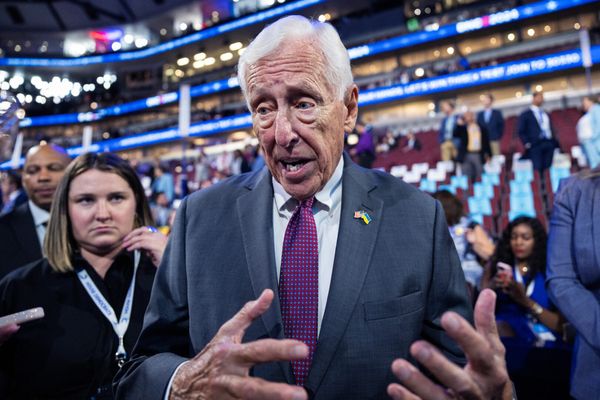
Perhaps this will be Theo Walcott’s breakthrough year. So went the cheap shot, heard into his 30s, that played with the idea an explosive talent never quite reached fulfilment. The jam was always promised for tomorrow; the 17-year-old taken to Germany 2006 for the ride never quite matured into an adult footballer’s body.
Now he has announced his retirement at 34 and, taking his career in the round, an alternative reading holds far more water. Walcott may have become a footnote since leaving Arsenal five years ago, summoning only glimpses at Everton and during a farewell tour back at Southampton, but there is a sense much of the previous decade was spent battling to meet an almost impossible standard.
What should Walcott have been? Perhaps it is smarter to look at what he actually was. Few forwards with 47 England caps are retrospectively marked as failures, even if those appearances came during a largely barren period for the national team. Arsène Wenger may have flirted with a few duds during his latter years at Arsenal but it said plenty that he persevered with Walcott, selecting him 397 times and starting him on 252 of them.
He scored 108 goals for Wenger, one of them in a victorious FA Cup final. These are hardly the numbers of a player who did not make it. They tell of somebody who made himself a success.
They are also a reminder that Walcott is joined only by James Milner in playing Premier League football every season between 2006-07 and 2022-23. During those early years the top flight had rarely seen speed like his: pace was an attribute he never really lost and it underpinned the rise that, shortly before the World Cup call-up from Sven-Göran Eriksson that raised expectations sky high, led him to become England men’s youngest senior player.
With exhilarating running ability comes a layer of added scrutiny. Could Walcott’s body and brain keep up with such a conspicuous gift that often leaves its owner exposed? There were rough edges to his game that never quite smoothed out; the microscope zoomed in further when, in 2008, he took the No 14 shirt Thierry Henry had vacated upon leaving Arsenal a year previously. Walcott had superstardom fitted out for him in advance and it meant any other outcome would seem, in some eyes, tantamount to failure.
Yet there were plenty of moments that showed why Wenger had plucked him from Southampton for £9m and why, almost a dozen years later, the pair’s mutual trust never really wavered. When Walcott sliced through Liverpool’s defence in a Champions League quarter-final at Anfield in 2008, setting up Emmanuel Adebayor for a tap-in that should have been the winner, it felt like a dizzying exhibition of skill and a night of coronation.

A year later he was scoring on the same stage against Villarreal, helping Arsenal to the last four; in 2010 it was his goal that turned an apparent cakewalk for Barcelona at the Emirates into one of the most exciting European ties of that decade. The following season, a solo effort at Shakhtar Donetsk was perhaps the crystallisation of peak Walcott: a breathtaking chase up the left flank before opening up his body for the kind of early, curled finish he had watched Henry produce time and again.
Amid all that came the hat-trick in Zagreb, the first competitive treble mustered by an England player in seven years, that confirmed the best result of Fabio Capello’s staid tenure. That was in September 2008 and if anyone had suggested Walcott would score only five more international goals at that point, three of them against Estonia and San Marino, they would have been considered a doom-monger. It remains one of the best performances by an England attacker in memory, which should perhaps temper criticism that there were not many more.
An unhappy injury record was one of Walcott’s hindrances: an assortment of issues, beginning with a shoulder problem and troughing with a ruptured cruciate ligament in 2014, ate into about two years of his Arsenal career. Another was the conjecture over where he should play. Walcott was an instinctive finisher and, in conversation, it rarely took long for him to mention that he had mapped out a future at centre-forward. He was unfortunate to come through at a time when the position was evolving, requiring an all-round suite of capabilities that never quite suited a player whose instinct was always to dart forward and seek space.
A thrilling display against Newcastle in December 2012, which brought a hat-trick and two assists, was his best offering as a striker; Wenger, perhaps quixotic to a fault regarding Walcott’s potential, was never quite willing to kill his dream. By 2016 the player had accepted that the wing, where the gaps in front yawned more invitingly than anywhere else, was his natural home after all.
Around the same time, Wenger offered a perspective on Walcott’s adventures. “Theo’s career is made of ups and downs,” he said. In that sense he mirrored an Arsenal era that was characterised by false dawns and overoptimistic promises of imminent domination but, regardless, still delivered annual Champions League football and more than one title tilt. He could be lampooned and lauded in the stands within the same minute but was sufficiently admired for “Sign da ting” to become a famous musical meme when a contract standoff threatened a departure in 2012.
Perhaps those oscillations themselves are proof of his success: given that the fast-tracking of youth talent had not yet come close to modern levels of mass production, it is arguable that Walcott’s output dramatically defied the odds. He did not need to become Lionel Messi, Cristiano Ronaldo or indeed Henry. A small percentage of today’s expensive youngsters are likely to match his figures. The journey, rather than any anticipated moment of arrival, was his mark of excellence.







